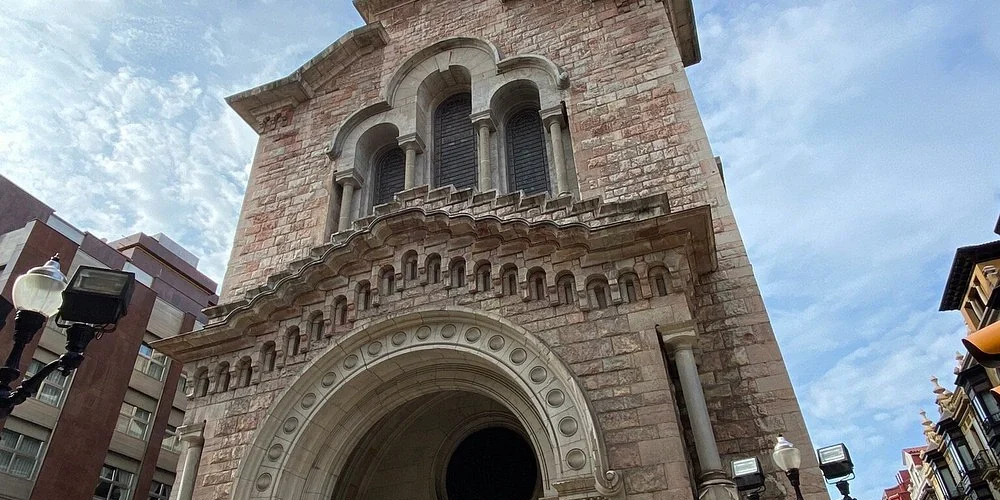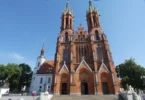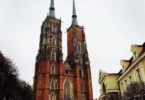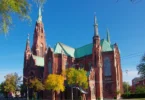Introduction
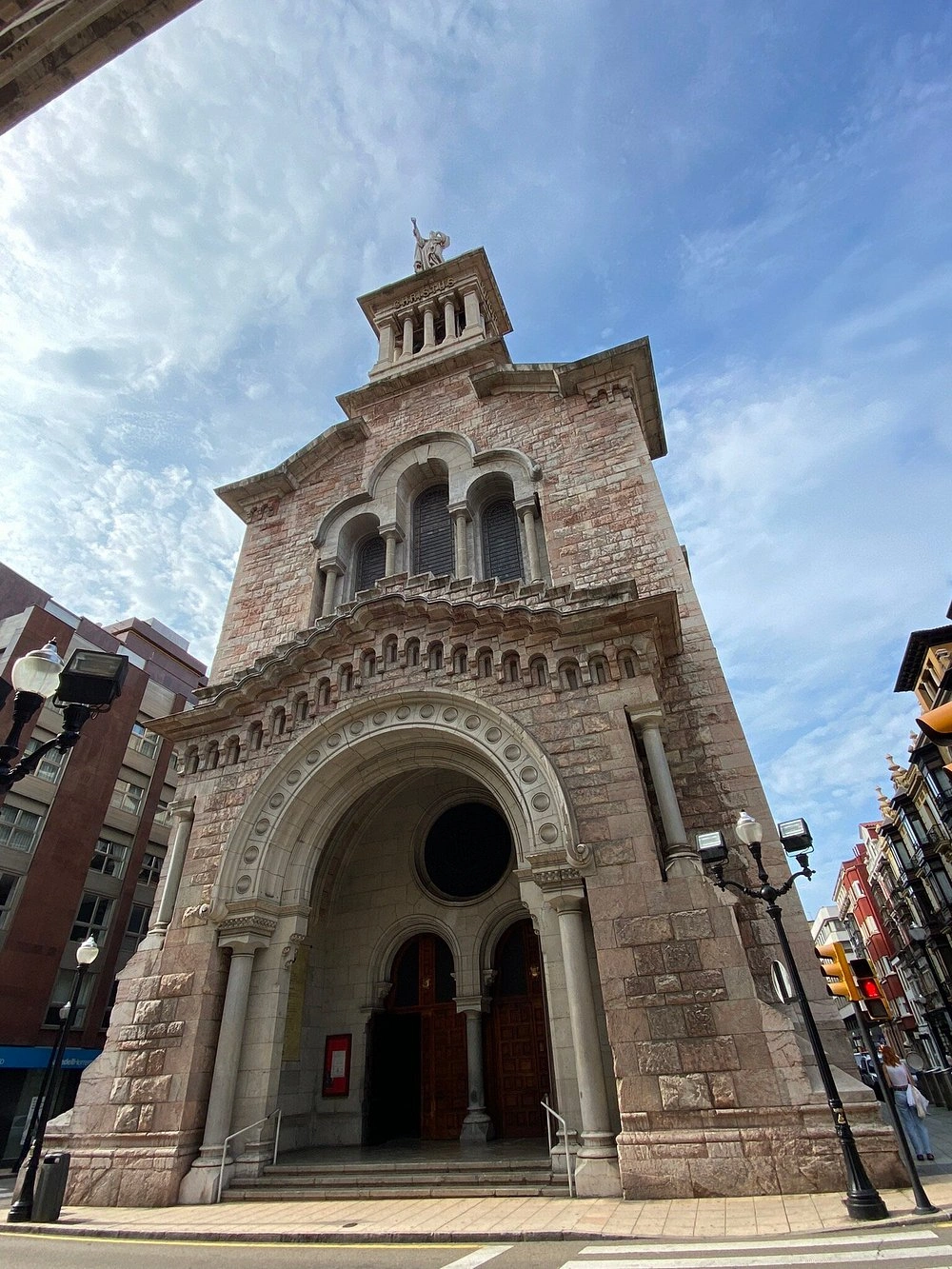
The Basilica-Sanctuary of the Sacred Heart of Jesus is a prominent religious and architectural landmark situated in the city of Gijón, within the autonomous community of Asturias, Spain. Commonly referred to by locals as “La Iglesiona,” this impressive temple commands a striking presence facing the Royal Jovellanos Institute, a historic educational institution. Constructed in 1918, the basilica exemplifies a unique blend of neo-Gothic and modernist architectural styles, reflecting the artistic trends of the early 20th century in Spain. Beyond its spiritual significance, the basilica holds a complex historical legacy, having been repurposed as a prison during the tumultuous period of the Spanish Civil War. Its walls thus bear witness not only to religious devotion but also to the socio-political upheavals that shaped modern Spanish history.

Construction and Architectural Vision
The Basilica of the Sacred Heart of Jesus, popularly known as La Iglesiona, was constructed in 1918 in Gijón, Asturias, Spain. It was designed in a distinctive blend of neo-Gothic and modernist styles, using pinkish stone from the Mount Naranco quarry the same material employed in the Basilica of Covadonga. The Jesuits conceived the entire structure as a symbolic representation of Catholic doctrine, aiming to inspire deep devotion. Every architectural detail, from the paired columns to the stained glass and inscriptions, was carefully planned to express the close relationship between Jesus Christ and the Church. The original project included two towers, but these were replaced by the imposing monument of the Sacred Heart of Jesus, a marble statue nearly eight meters high that dominates the façade.
Symbolism and Artistic Decoration
The basilica’s interior is richly decorated with paintings by the Bavarian brothers Wilhelm and Heinrich Immenkamp. Their works, created over nearly two years, include detailed depictions of virtues, sacraments, and the Christian path of salvation across the vaults and apse. The apse, in particular, features a grand painting of the Last Judgment with over 800 figures, including numerous Jesuit saints. Latin inscriptions, many from the Vulgate Bible, adorn the walls and arches, requiring contemplation to fully grasp their theological meanings.
Spanish Civil War and Use as Prison
During the Spanish Civil War (1936–1939), the basilica was transformed from a sacred space into a prison, a stark shift reflecting the turbulent political and social climate of the time. This period saw significant disruption to religious practice and damage to the building’s structure and decorations. The transformation illustrates the complex history of the Church and its buildings during the war years in Spain.
Fire of 1930 and Subsequent Restoration
Prior to the war, the basilica suffered a devastating fire in 1930, which destroyed several important artistic elements, including the paintings of the Stations of the Cross and original walnut galleries. Despite this damage, restoration efforts over the decades have preserved much of the basilica’s interior and exterior. The stained glass windows, ironwork gates, and many sculptures remain, continuing to communicate the original religious symbolism envisioned by the Jesuits.
Modern Role and Legacy
Today, the Basilica of the Sacred Heart remains one of Gijón’s most important religious and cultural landmarks. It serves as a place of worship, pilgrimage, and education about Catholic doctrine through its architecture and art. The large statue of the Sacred Heart, visible from various points in the city, continues to be a powerful symbol of faith. The basilica’s history, from its grand construction to its wartime repurposing, adds to its significance as a monument to both spiritual devotion and the resilience of the community.
Architecture of Basilica of the Sacred Heart, Gijón, Spain
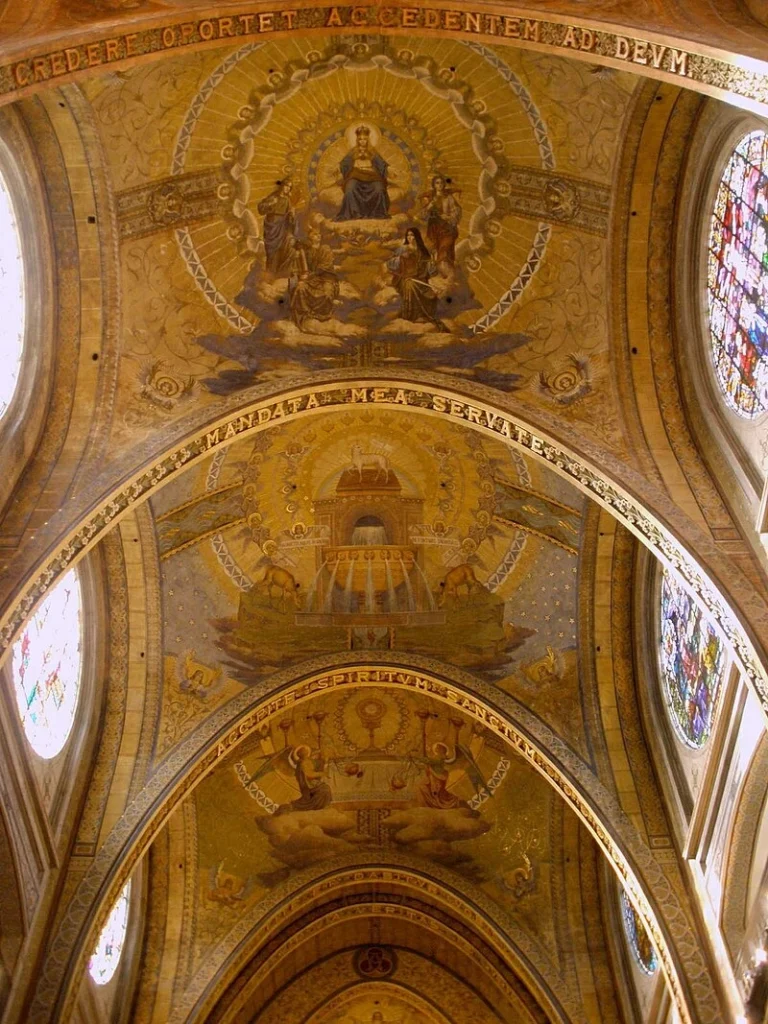
Architect : Joan Rubió i Bellver
Architectural style : Eclecticism architecture, Gothic – Modernism architecture.
Symbolism and Religious Meaning
The Basilica-Sanctuary of the Sacred Heart of Jesus was carefully conceived to embody multiple layers of Catholic doctrine and to inspire profound devotion among its visitors. This spiritual and symbolic purpose was central to the Jesuits’ vision and interpretation of the temple’s design. While many symbolic elements are easily recognizable to anyone with a basic understanding of Catholic tradition, others have grown less accessible due to changes in religious customs and the passage of time. Decoding some of the numerous Latin inscriptions presents a particular challenge because many are partially deteriorated or exhibit unclear spelling. For proper understanding, these texts often require patient study alongside the Vulgate Bible, from which most inscriptions are derived. Jesuit scholars from the church’s founding era and their close successors maintained that nearly every significant feature of the basilica serves to express, in symbolic form, the intimate and foundational relationship between Jesus Christ and His Church.
Architecture and Structural Features
The basilica’s construction emphasizes solidity and grandeur, predominantly using pinkish stone quarried from Mount Naranco, the same source used for Asturias’s iconic Basilica of Covadonga. Architecturally, the church follows a traditional single-nave plan, with a spacious atrium at the front and an ambulatory encircling the presbytery. The nave is divided into four large vaults plus an apse cap, all supported by ten paired columns that run alongside the ambulatory. The transverse arches between vaults are oval or semicircular, while four galleries on each side sit above the lower arches—these galleries originally featured finely carved walnut balustrades that were later lost. Master builder Claudio Alsina Bonafont documented precise dimensions: the temple measures approximately 45.9 meters along Begoña Street and 45.6 meters along Instituto Street, with a façade width of 17.45 meters and an interior width averaging 15.15 meters. The vaults reach a height of 27 meters above the pavement, spanning roughly 11 by 10 meters. According to the Land Registry, the basilica covers about 775 square meters, with an adjacent residence occupying 319 square meters, combining for a total built area of approximately 1,365 square meters.
Consecration Inscription
A prominent consecration inscription is located on the first wall section to the left upon entering, roughly two meters above ground level. Though partially deteriorated and now covered by wooden panels, the inscription’s tentative translation reveals its historical and religious significance. Dated May 1924, it marks the church’s dedication on the feast day of Ferdinand, King of León and Castile. The text honors the reign of King Alfonso XIII and commemorates Spain’s fifth anniversary of an important event, likely related to the church’s founding or Catholic restoration efforts. It also acknowledges the church’s dedication to the Sacred Heart of Jesus, the care of the Jesuit “children” (followers of Ignatius of Loyola), and the generous support of Christ’s faithful, including local citizens of Gijón. The inscription stands as a testament to the church’s Jesuit foundation and its deep historical ties to Spain’s Catholic monarchy.
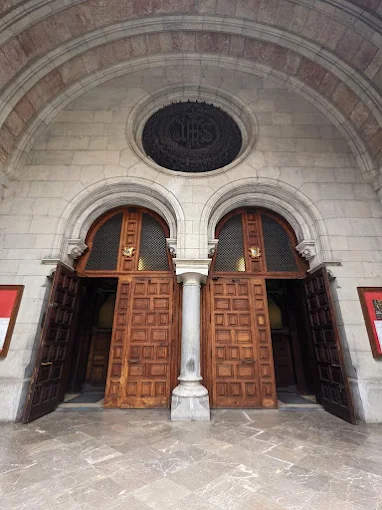
Main Façade
The basilica’s main façade presents a visually complex and somewhat inharmonious composition, mainly due to alterations from the original architectural plans. The façade is divided into three distinct horizontal sections: the lower entrance area, a middle section dominated by stained-glass windows, and the uppermost monument dedicated to the Sacred Heart of Jesus. The entrance projects outward and was originally crowned by the Cross of Victory, flanked by five-meter-high statues of Saints Peter and Paul carved from Ondárroa stone. These statues symbolized their role as guardians of the Church and guides for the faithful entering its doors but were destroyed in later years. The entrance arch spans over 9 meters and contains an elegant Modernist iron gate, one of the finest examples of ironwork in the city, which has retained its grandeur despite some damage over time. Above the door is a mullioned window topped with a rose window featuring an intricate wrought iron grille adorned with the JHS Christogram and a crown of thorns motif intertwined with abundant floral decoration.
The middle section contains three tall stained-glass windows—one central nine meters high, flanked by two seven-meter-high windows—providing light to the choir area. Large pillars on either side mark the intended bases of two towers that were never built. Four statues of Jesuit saints—Saint Ignatius of Loyola, Saint Aloysius Gonzaga, Saint Francis Xavier, and Saint Stanislaus Kostka—were once mounted on corbels beneath the Sacred Heart monument, symbolizing the church’s spiritual foundation on the Apostolic tradition. These statues, each four meters tall and weighing seven tons, were also destroyed. An inscription between the saints once declared, “COR IESV ADVENIAT REGNVM TVVM” (“Heart of Jesus, Thy Kingdom Come”), but it disappeared after a 1930 fire and the church’s subsequent restoration.
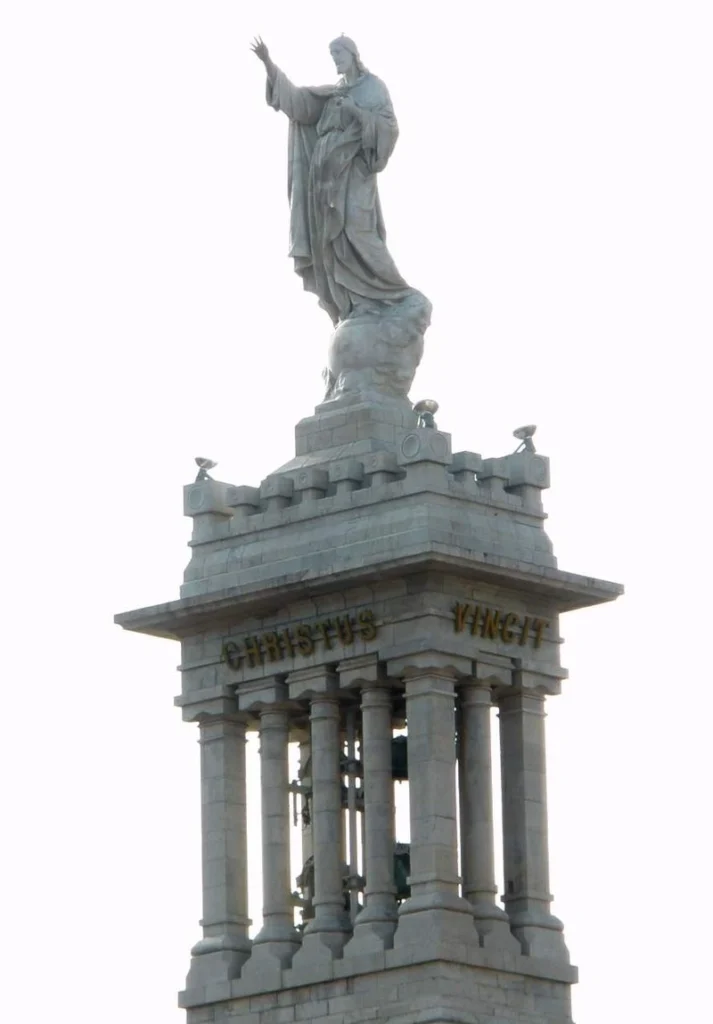
Monument to the Sacred Heart of Jesus
The uppermost section of the façade is dominated by the monumental statue of the Sacred Heart of Jesus, carved from nineteen blocks of Carrara marble. Measuring 7.75 meters tall and weighing 32 tons, the statue’s head reaches nearly 50 meters above street level, making it one of the tallest landmarks in Gijón. Jesus is depicted pointing to His heart with one hand while blessing the city with the other, symbolizing His love and protection over the faithful. The statue rests on a large quadrangular pedestal supported by twelve columns, which symbolize the twelve Apostles—the foundational pillars of the Church, as referenced in Ephesians 2:20. This striking figure was once the second-largest Sacred Heart statue in Spain, after the famous one on Cerro de los Ángeles, and was illuminated at night by a projector located on a nearby school’s turret, enhancing its visibility. Locally nicknamed “El Santón” (“The Saint”) for its impressive size, the statue remains visible from many points throughout the city. A bronze inscription on all four sides of the pedestal reads, “CHRISTUS VINCIT REGNAT IMPERAT” (“Christ conquers, reigns, and commands”), reinforcing the message of Christ’s sovereign reign over the world. The sculptor responsible for the statue and the accompanying Jesuit saints was Serafín Basterra Eguiluz from Bilbao.
Interior Decoration and Artistic Works
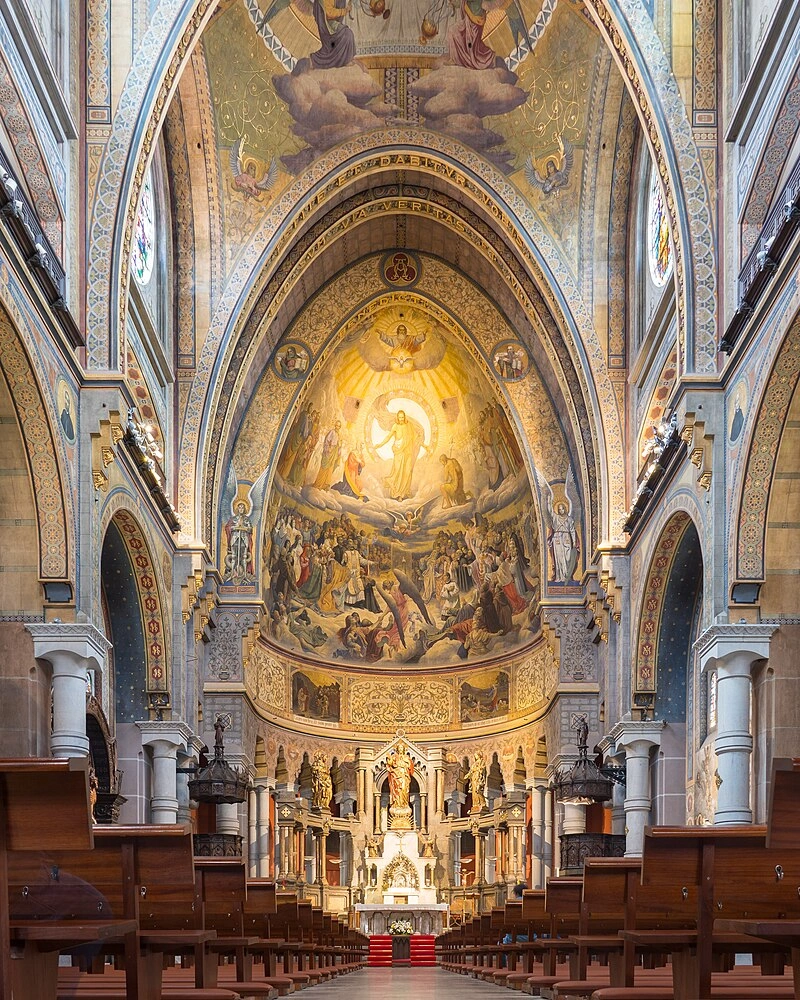
The basilica’s interior is richly adorned with pictorial decoration by the Bavarian brothers Wilhelm and Heinrich Immenkamp. They spent nearly two years completing the church’s extensive frescoes and paintings using tempera and oil paints, following detailed studies and preliminary sketches. Their artwork ranges from intricate geometric motifs to the monumental Last Judgment scene, which covers approximately 120 square meters of the apse, depicting the triumph of the righteous. Floral borders and medallions decorate the side walls, particularly within the spandrels of the low arches. Unfortunately, the original Stations of the Cross painted by the brothers were completely destroyed in the 1930 fire, though much of the remaining decoration survives and continues to enrich the church’s spiritual and artistic ambiance.
Doctrinal Progression and The Path to Christ in the Ceiling Paintings
The ceiling paintings, encompassing the four vaults and the apse, articulate a profound doctrinal progression aligned with the core teachings of the Catholic faith. Each vault represents a fundamental aspect of the Christian journey toward salvation, integrating catechetical symbolism with artistic expression to guide the believer spiritually within the Church. The first vault, dominated by the color red, embodies Faith as the essential entrance into the Church, visually anchored by the depiction of St. Peter’s Basilica—the epicenter of faith’s divine radiance—accompanied by angels and the four evangelists. The inscription “CREDERE OPORTET ACCEDENTEM AD DEVM” reinforces faith’s pivotal role. The second vault shifts focus to the Practice of Virtues, portraying Charity crowned at the center, surrounded by the cardinal virtues Prudence, Fortitude, Justice, and Temperance. This vault reflects the Catholic emphasis on faith expressed through works, contrasted with Protestant doctrine, and bears the command “MANDATA MEA SERVATE,” urging adherence to God’s commandments. The third vault symbolizes Grace through the sacraments, featuring the Mystic Lamb above the Book of the Seven Seals, with flowing water dividing into seven streams to signify the sacraments nourishing the soul, accompanied by the inscription “ACCIPITE SPIRITVM SANCTVM,” highlighting the Holy Spirit’s sanctifying role. The fourth vault is dedicated to Prayer and the Eucharist, with the Blessed Sacrament displayed in a monstrance, surrounded by angels offering incense representing prayers ascending to Heaven, and inscribed with “PETITE ET DABITVR VOBIS,” emphasizing the efficacy of prayer. Together, these four vaults encapsulate the Christian’s path of faith, virtue, grace, and prayer within the Church. This spiritual journey culminates in the fifth arch’s powerful declaration, “EGO SVM VIA VERITAS ET VITA,” affirming Jesus Christ as the ultimate way, truth, and life for the believer, thus completing the theological and visual narrative of salvation etched into the church’s ceiling.
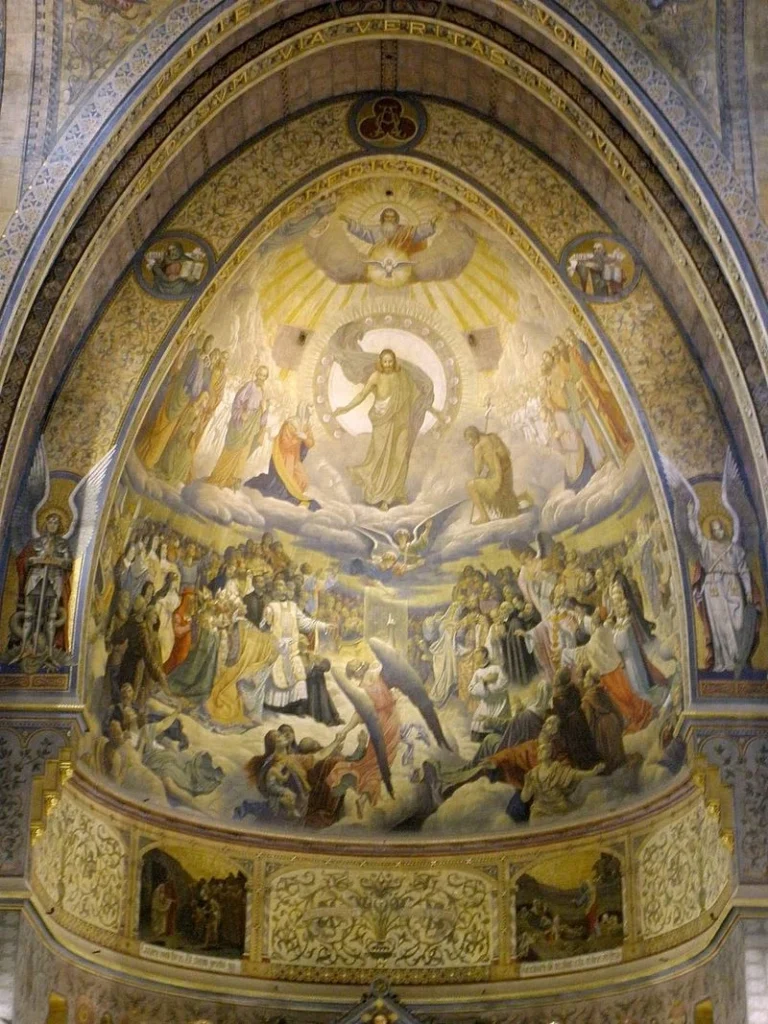
The Apse: The Final Triumph Resurrection and Last Judgment
The apse’s vast vault, covering approximately 120 square meters, is dominated by an elaborate and powerful depiction of the Triumph of the Righteous at the Last Judgment. At the center of this monumental composition stands Christ as the divine judge, encircled by a luminous mandorla that includes the Father and the Holy Spirit, symbolizing the Holy Trinity. This radiant light evokes the Son of Man’s banner described in Matthew 24:30, underscoring Christ’s authority and glory. To Christ’s right are revered figures including the Virgin Mary, Saint Joseph, and apostles such as Saint John and Saint James the Less, while to His left stand Saint John the Baptist and apostles like Saint Thomas and Saint Paul. Behind them, a multitude of angels fade into the background, enhancing the heavenly setting. Below this celestial assembly, the painting portrays the vast throng mentioned in Revelation 7:9—people of all races and ages who have been purified through tribulation. An angel actively encourages these faithful toward the divine throne, lifting some resurrected souls heavenward, symbolizing salvation and eternal reward. The saints are depicted with a range of expressions reflecting their spiritual states—from contemplative serenity in figures like Saint Ignatius of Loyola, Saint Thomas Aquinas, and Saint Cecilia, to intense love for Christ seen in Saint Charles Borromeo and Saint Francis of Assisi. The inclusion of notable Jesuit saints, historical figures such as Saint Ferdinand III, and the church’s founder, Father Cesáreo Ibero, links the painting to the local ecclesiastical heritage. Restoration studies reveal meticulous craftsmanship, with no evidence of retouching or underdrawing apart from guiding red and black lines for figure placement. Notably, the painter Wilhelm Immenkamp left a subtle self-portrait behind an angel’s wing and signed the work, adding a personal touch to this sacred narrative. Below the main painting, a frieze adorned with plant motifs bears the inscription “EXSULTABUNT SANCTI IN GLORIA” (Psalm 149:5), encouraging the faithful to rejoice in divine glory. Flanking the frieze are two resurrection scenes drawn from traditional Mass readings: the raising of Lazarus on the Gospel side and Ezekiel’s vision of dry bones on the Epistle side, reinforcing the themes of resurrection and renewal. Above the nave’s columns, twelve small medallions depict symbols of the sacraments, the Sacred Heart of Jesus, and Christograms (JHS), deepening the theological richness and continuity of the apse’s iconography within the church’s overall spiritual program.
Wall Paintings: Jesuit Saints and Religious Iconography
The side walls feature sixteen medallions, mainly painted by the Immenkamp brothers, many dedicated to Jesuit saints canonized around the time of the church’s decoration. Positioned below the side galleries in spandrels, these include portraits of Saint Francis of Jerome, Saint Robert Bellarmine, Saint Peter Canisius, Saint Peter Claver, Saint Francis Xavier, Saint John de Brito, Saint Alonso Rodríguez, Saint John Berchmans, Saint Francis Borgia, Saint Ignatius of Loyola, Saint Stanislaus Kostka, and Saint Aloysius Gonzaga. Also present are important religious emblems like the papal coat of arms of Saint John Paul II and the emblem of the Holy See, both added during the 2008-2009 restorations.
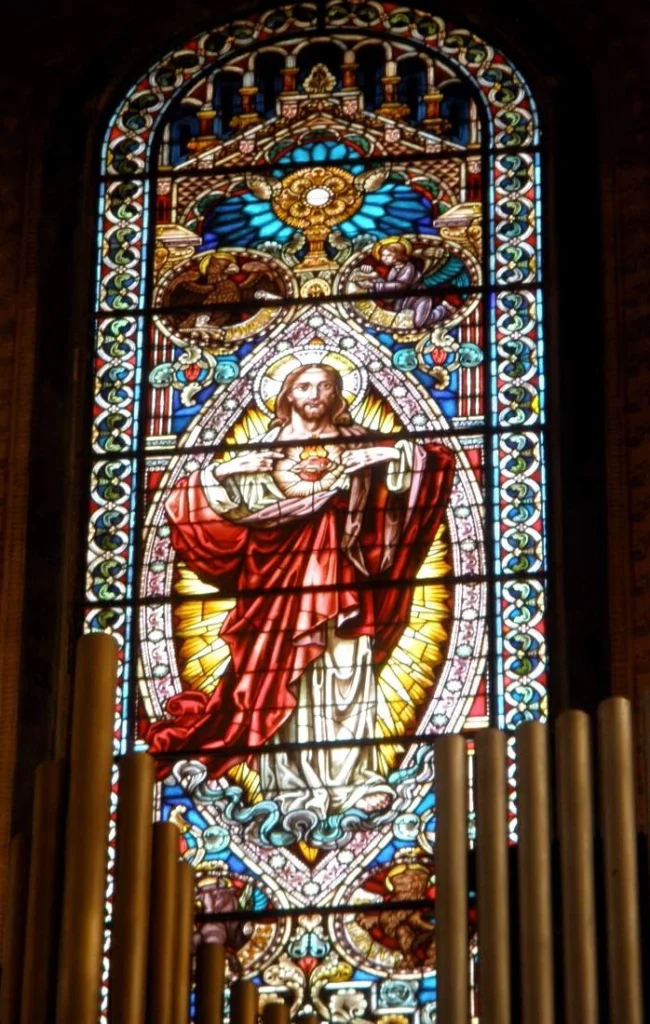
Overview of the Stained Glass Windows
The church is adorned with an extensive and richly symbolic array of stained glass windows, which together form a comprehensive catechetical narrative. These include eight large circular windows positioned high on the side walls, eight sets of smaller windows on the lower parts of the same walls, three significant choir windows, and a distinctive bull’s-eye window above the entrance. All these windows are crafted in a modernist style by the renowned Maumejean Hermanos House. Many original windows were tragically destroyed during a violent attack and fire in 1930, but the same workshop expertly reproduced the lost artwork during the church’s reconstruction, preserving both the theological themes and stylistic coherence of the original program.

Large Circular Windows: Episodes from the Life of Christ
The eight large circular stained glass windows along the upper side walls vividly depict major episodes from the life of Jesus Christ in chronological order. Each window, nearly five meters wide, combines rich imagery with Latin inscriptions drawn from Scripture to deepen the spiritual message. Starting with the Nativity, the birth of Christ is joyfully proclaimed with the phrase “CHRISTUS NATUS EST NOBIS, VENITE ADOREMUS” (“Christ is born for us, come, let us adore him”), accompanied by angels praising God. The Hidden Life shows Jesus’ obedience to Mary and Joseph, marked by “ET ERAT SUBDITUS ILLIS” (“And he was subject to them”). The Baptism scene highlights John the Baptist’s role and God’s approval: “HIC EST FILIUS MEUS DILECTUS” (“This is my beloved Son”). The Sermon window illustrates Jesus teaching the crowds, encouraging vigilance with inscriptions like “VIGILATE ITAQUE” (“Be awake therefore”). The Institution of the Eucharist commemorates the Last Supper with Christ’s command to “Do this in memory of me.” The Prayer in the Garden captures Jesus’ submission to God’s will in Gethsemane, while the Crucifixion window solemnly states “CONSUMMATUM EST” (“It is fulfilled”), signaling Jesus’ sacrifice. Finally, the Ascension portrays Christ rising to heaven, promising His eventual return. These windows not only decorate the church with brilliant color but also tell the central story of Christianity, guiding worshippers through key moments in Christ’s life.

Choir Windows: The Sacred Heart and Evangelists
The three large stained glass windows above the choir form a triptych centered on the Sacred Heart of Jesus, enclosed in a mystical mandorla. Surrounding the Heart are medallions bearing the symbols and names of the four evangelists. Above, a Eucharistic scene crowns the window, while below rests the Christogram “JHS” alongside the inscription “COR JESV SACRATISSIMVM” (Most Sacred Heart of Jesus). Donor inscriptions honor Ignacia and Josefina Velasco. The adjacent windows on the Epistle and Gospel sides show angels holding shields emblazoned with the Heart of Jesus, accompanied by plant and geometric motifs and manufacturer’s marks. One shield bears the “Detente” image linked to Saint Margaret Mary Alacoque, signifying devotion and protection.
Entrance Bull’s-Eye Window
The circular bull’s-eye window at the church’s entrance is largely obscured from the outside by an ornate protective grille. Viewed from within, the window reveals a radiant Heart of Jesus superimposed on the IHS Christogram at its center, surrounded by golden rays emanating outward. The peripheral sections of the window are adorned with intricate plant motifs, combining spiritual symbolism with delicate artistry.
Main Chapel
The ambulatory of the main chapel is formed by double Naranco stone columns supporting the apse wall. The main altarpiece, crafted from polished Naranco stone with alabaster and Carrara marble details, once featured five polychrome cedar statues by Lorenzo Coullaut Valera, destroyed in the 1930 attack and later replaced. The monstrance was removed after the Second Vatican Council reforms, and several images were taken away when the Jesuits sold the church, leaving the altarpiece sparse and rearranged. The altar’s placement changed from against the reredos to the edge of the presbytery steps, complicating some liturgical ceremonies. A notable feature is the large tabernacle, made in Barcelona with fragrant woods, gold, and embossed silver donated by local devotees, designed like a Roman basilica and adorned with angelic figures and inscriptions emphasizing Christ’s presence. After damage and relocation during the 20th century, it was reinstalled in the Basilica in 2019. Only the stone bases of the original pulpits remain; the rest were replaced with wooden carvings after 1942.
Chapel of Christ
Located on the nave’s left side, the Chapel of Christ contains a wooden statue called Christ of Peace by Miguel Blay, considered a masterpiece of 20th-century religious art. The altar and altarpiece date from post-reconstruction and feature motifs from the Passion. A partial Trinitarian image appears on the wall above. Latin inscriptions encircle the chapel, praising Christ’s redemptive sacrifice, with medallions bearing Christograms and triumphant phrases.
Chapel of the Virgin
On the right side of the nave, the Chapel of the Virgin honors the Virgin of Covadonga with an altar and a mural depicting the Immaculate Conception, including traditional symbols like the sun, moon, serpent, and twelve stars. The mural includes angelic figures holding bands with Marian prayers and inscriptions from ancient antiphons and the Litany of Loreto. Some parts were altered by a lesser artist after reconstruction. During the church’s use as a prison in 1936-1937, the image became a symbol of devotion among prisoners, earning the title “Queen of the Martyrs,” commemorated by a nearby tombstone.
Sacristy
The sacristy is a spacious and once sumptuous room, furnished with large chests and cupboards made of finely carved wood, showcasing intricate openwork details reminiscent of medieval Asturian craftsmanship. These original pieces are well preserved, except for a crucifix that once adorned the main furniture, which has disappeared. The sacristy’s furnishings survived the widespread destruction during religious persecution, likely due to their practical use, and were later spared from replacement during the temple’s restoration between 2006 and 2009.
Feast Day
Feast Day : 27 June
The Basilica of the Sacred Heart in Gijón, Spain, celebrates its feast on the Feast of the Sacred Heart of Jesus, held annually on the Friday after the second Sunday of Pentecost. This important Catholic celebration honors Christ’s love and mercy. In 2025, the feast will be celebrated on June 27, with special Masses and local religious events.
Church Mass Timing
Monday to Friday : 9:00 AM, 12:30 PM, 7:30 PM
Saturday : 9:00 AM, 12:30 PM, 6:00 PM, 7:30 PM
Sunday : 10:00 AM, 11:00 AM, 12:00 PM, 1:15 PM, 7:30 PM
Church Opening Time:
Monday to Saturday : 08:00 AM – 1:30 PM, 5:00 PM – 8:00 PM
Sunday : 09:30 PM – 2:00 PM, 5:30 PM – 8:00 PM
Contact Info
Address : Basilica of the Sacred Heart
Calle Instituto, 34, Centro, 33201 Gijón, Asturias, Spain.
Phone : +34 985 35 03 02
Accommodations
Connectivities
Airway
Basilica of the Sacred Heart, Gijón, Spain, to Asturias Airport (OVD), distance 31 min (40.7 km) via A-8.
Railway
Basilica of the Sacred Heart, Gijón, Spain, to Estación de Gijon-Sanz Crespo Adif Calle Sanz Crespo, Gijón,distance between 5 min (1.6 km) via C. Sanz Crespo/GJ-81.

